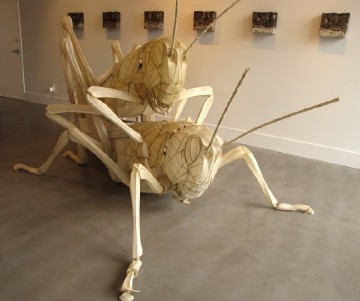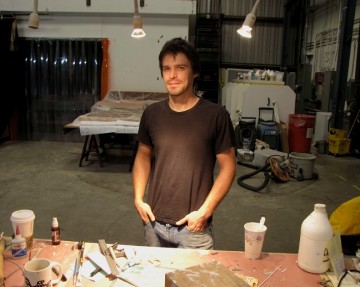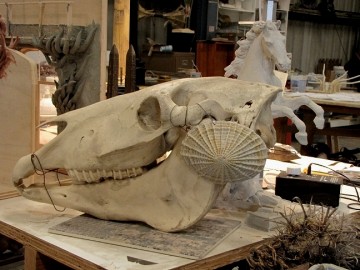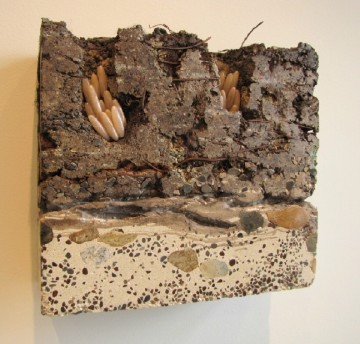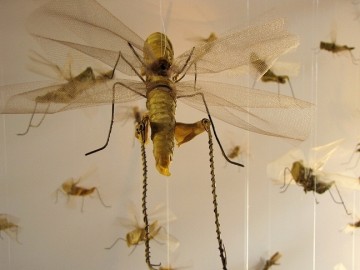If you saw the science fiction movie Starship Troopers a few years ago, you have already seen Oakland sculptor Cyrus Tilton’s handiwork—both literally and figuratively: the hands mangled in that alien-bug movie were made from molds on his hands. The exploding brains were also his concoction: Karo syrup and red food coloring (Tinseltown’s traditional recipe), plus breadcrumbs and scrambled eggs from Tilton’s catered lunch. That film’s director, Berkeley’s special-effect wizard, Phil Tippett (The Empire Strikes Back, Dragonslayer, Jurassic Park, Dinosaur!), gave Tilton his first job when he moved to the Bay Area after art school in Seattle; his current employer is Ron Holthausen, a scientifically-inclined artist whose design/display company, Scientific Art Studio (SAS) in Richmond, north of Berkeley, has adopted the apt motto, Natura artis magistra docet, Nature is the teacher of art.
SAS does work for museums (dioramas, architectural models, reconstructed extinct animals and plants), fine-art collectors (murals, sculptures, tiles, paintings and installations) and films and television (scale models, creature design, special effects, paintings, and props). Tilton once wanted to work in sci-fi/horror movies (and still confesses to a love of the “lowbrow”), but his work as SAS’ Art Director and Lead Artist has given him invaluable scientific and technical experience—perhaps exceeding what he could have learned in computer-graphics-driven Hollywood genre films. When I visited the artist at his workplace recently, Tilton, surrounded by SAS props, maquettes, and tools, looked around the vast warehouse, and reflected on the relationship between his job and his fine-art work: “It’s very cause-and-effect. It [the exchange of ideas] becomes second nature, and you get paid for it.”
That day-job creative flow is evident in his surreal, mysterious sculptures of humans and animals. In 2010, his show at Oakland’s Vessel Gallery, A Place In-Between, featured human-machine hybrids that elicited from this writer a comparison with Guillermo del Toro’s disturbing and enchanting film, Pan’s Labyrinth. For a show last spring, Tilton created sculptures of animal protagonists—ant and grasshopper, fox and grapes—taken from fables and folklore. Tilton’s current show, The Cycle, is no less suggestive in its satirizing of humankind’s conformist and consumerist instincts: we’re like locusts, grasshoppers that overbreed when conditions are right and, at a certain level of tactile stimulation from overcrowding, mutate from solitary feeders to billion-bug superorganisms that devastate crops wherever they land—the entomological equivalent of slash-and-burn Third-World agriculturalists or their technologically but not morally advanced First-World analogues.
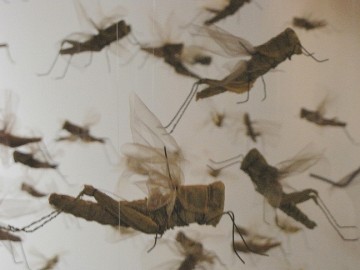
Cyrus Tilton. "Individuals," 2011. Steel, muslin, tulle, jute twine,Bamboo, electric mechanism and device, metal screen, and individual locust. 32' x 15'.
A cinematic precedent, unknown to Tilton when he began the project, is the 1967 film, Five Million Years to Earth, or (to cite its original British title) Quatermass and the Pit, in which scientists investigating an ancient spacecraft excavated beneath a London street discover a disquieting fact: that, long ago, primitive humans were implanted with the memories of long-extinct Martian scientists—our grasshopper-like creators—and that we, their descendants, are susceptible to reliving, maddened by hallucinations, those primordial alien “cleansings of the hive,” and attacking “different” others, telekinetically. Tilton’s three-part show comprises a sculpture, The Lovers, a pair of larger-than-human mating locusts fashioned from steel tubing and damar/beeswax-impregnated muslin; Individuals, an installation of nearly five hundred handmade locust puppets suspended on fishing line and animated into swarming flight by a motor-driven camshaft; and nine Potential wall reliefs, trompe-l’oeil masterpieces representing sections of earth (dirt, clay, pebbles) pierced by locust ovipositor tunnels and their glistening bundles of eggs—both beautiful and scary, like human overpopulation and mutation.
In a recent interview with Lonnie Lee of Vessel Gallery, Tilton elaborated on why he made The Cycle, and how his pessimism about the human future was mitigated and moderated by the outpouring of support from friends, family and colleagues. A few excerpted quotes from the interview follow.
“The Cycle uses the locust as a metaphor for my fears of human population growth falling out of balance with a sustainable environment, ultimately becoming a self-sabotaging mass of consumers whose end will only be seen once the last blade of grass is gone or a massive natural disaster resets the cycle.”
“…[P]eople in the US don’t seem to produce anything anymore. Now the US has turned into a place where ideas are being sold intangible things. So much is based around computers and the Internet, and not physical things … we’ve given that away to other countries. Kids are growing up in an environment where they aren’t expected to produce. … Are we becoming more like insects? When I drive by an apartment building I can’t help but see it as a hive. These apartments seem like compartments for individuals to live in and we are connecting ourselves in ways that are like worker bees or worker ants feeding the queen ant, and are we getting closer to that kind of life, the life of an insect, and is that bad? Or maybe we are already closer to insect hierarchies that we like to think.”
“I can’t help but compare humans to insects. We are born into consumerism, and we are constantly bombarded by the media with messages that tell us, “You are going to be a consumer. You are going to join the ranks of the consumers.” Consuming stuff is a very human thing to do, but we are being exploited, or we are allowing ourselves to be exploited in that way?”
“The swarm idea — I wanted to create an environment where you are standing in the middle of a mass of individuals that feels like a single entity…. locusts actually change physically when they swarm. They start to bump into each other, and that promotes a physical change which wouldn’t normally occur… Basically, something happens to change the balance of the insects ecosystem and all of the sudden, they’re out of control, everything goes into overdrive…They swarm. They eat themselves out of house and home and move on to another area. They eat till they can’t eat anymore and then they die off. There is chaos, but I feel like in that chaos there’s something trying to find balance again, and that intrigued me… I will never see a locust swarm, so basically this is a way for me to satisfy that urge and feel what swarming is like.”
“During the early stages of my creative process I’m often driven by cynical emotions influenced by my visceral views on society. As I worked on the pieces for The Cycle, I got the chance to spend time with my thoughts on overpopulation and consumption. While working on The Cycle I have called for a great deal of help from my community to make the show possible. Without the promise of a paycheck, a small army of friends and family enthusiastically gathered to help in production and problem solving, not to mention emotional support. The experience of working with people towards a common goal allowed me to re-examine my original thoughts on this show as well as promoted some unexpected personal growth. From this experience I am taking a cautious but exciting step towards optimism.”

